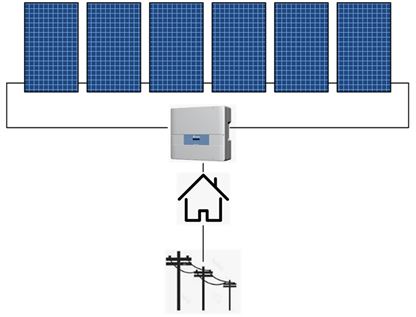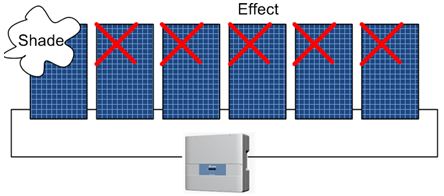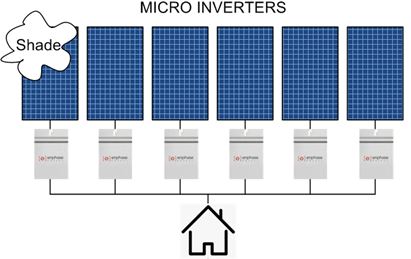A solar grid system is very simple in terms of the functional parts involved – accessory parts aside, there are solar panels and inverters and that’s it. Solar inverters are typically available in two main types – what they call string inverters and micro-inverters. Micro-inverters are the topic of this blog, but understanding them is greatly benefited by having a quick look at the original and most common type – string inverters.
String inverter’s require a number of solar modules to be connected together in order to make it operate – hence a ‘string’ of panels. The panels are connected in series to develop a high overall voltage (typically 200 to 450VDC) which is easier to convert to the 240V AC that our electrical network operates at. Usually 6 to 12 panels are connected in the string, so most homes only have one or two strings of panels installed.

So the biggest shortfall of this system… If you shade just part of a solar module, it throttles back the whole panel, and because the solar panels are connected together in series ‘end to end’ much like a tube, the throttled solar panel throttles back all the other panels in the string too. So just a small square of shade can significantly affect the output of half or even all your solar array.

Enter the Micro-inverter. With this setup every single solar panel has its own small personalised inverter. Shade over part of a solar module will still affect the output of the whole panel but it wont affect any of the other panels in the system.

In addition, the output of every solar panel is maximised. Even though solar panels are rated at a certain number, 350W for example, many of them actually produce more, say 354W or 355W. In a string inverter system every panel is limited to the power of the weakest one in the string, but in a micro-inverter system every panel generates at its fullest potential. This is one reason why some micro-inverter manufacturers claim that their system will gain an 8% improvement on generation compared to a conventional string inverter system.
This last point is important as the less-attractive quality of microinverters is increased cost. You can’t add all those extra electronics without a higher price tag. Micro-inverters can add another $1000-$2000 to the cost of a solar system. So what are the other benefits? Micro-inverters offer advanced system monitoring that can graph performance in detail of every solar module. Aside from pleasing the people who love information and performance visibility, this can be very useful for early detection of any issues with solar panels, wiring, or the inverters themselves. Some companies offer to actually contact you if their computer system detects a potential problem. With string inverter systems it may take one or two bill cycles to notice something is up.

The environment on the roof under a solar panel in the heat and moisture is a challenging place for electronics to live out their life. In my opinion you should only trust the most reputable and well-established brands in micro-inverters under these conditions.
In summary, if you have a roof with clear open access to the sun and no potential shading issues, then you should be well serviced from a string inverter system and can save yourself a few dollars. If you are likely to experience any form of significant shading on your roof from buildings, trees, power poles, or any other objects, it is strongly advisable to consider micro-inverters which although more expensive, will result in higher generation and are likely to present a better economic proposition over time.
